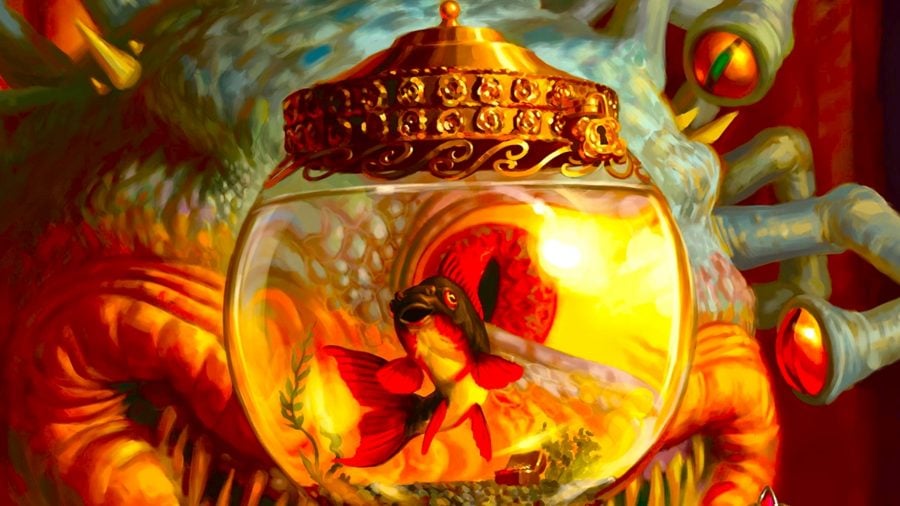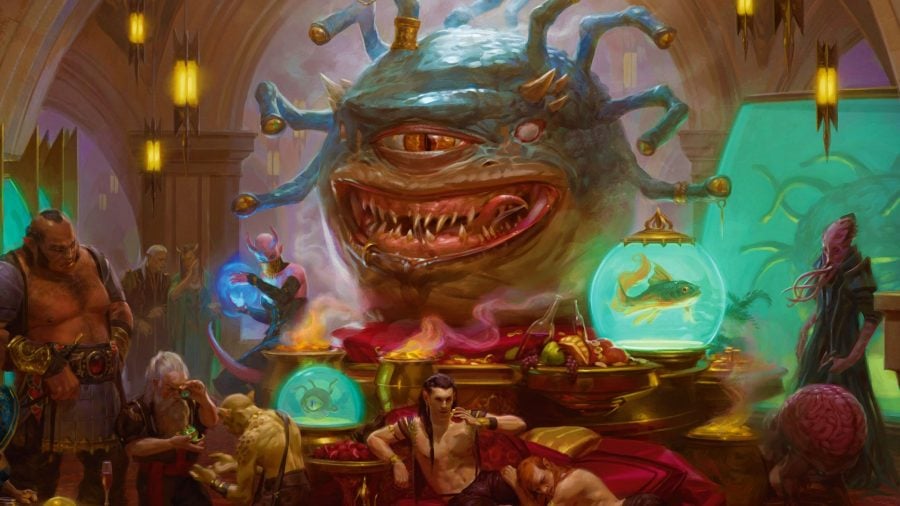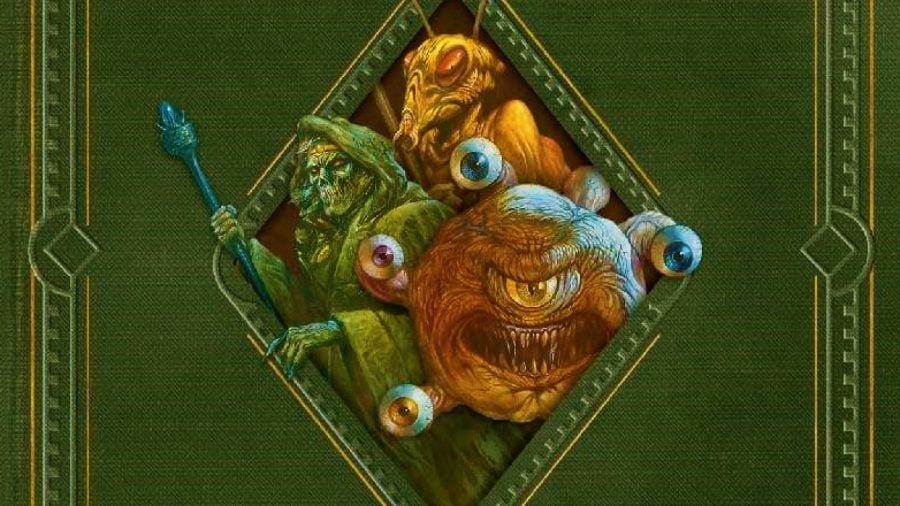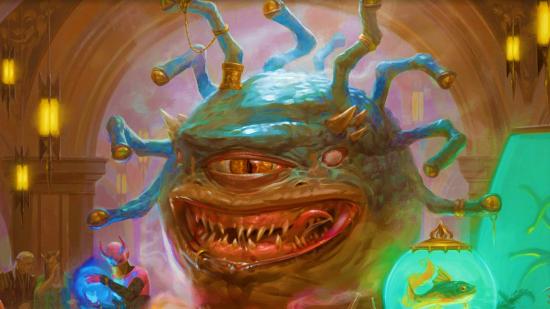The many-eyed Beholder 5e monster is one of the most recognisable creatures in the world of Dungeons and Dragons. Picture this: your D&D party enter a lair of many chambers, armed to the teeth and ready to take on whatever slumbers there. You pick through piles of minions and scattered treasure, and you’re suddenly struck from above. Down floats a Beholder, a floating ball of paranoia, calculation, and eyes, eyes, eyes.
You can find DnD dragons just about anywhere, and plenty of other fantasy worlds have adopted their own version of other DnD staples, such as the Mimic 5e monster – but the Beholder remains unique and synonymous with Dungeons and Dragons. The DnD Beholder is an icon, and that means there’s plenty of reason to learn more about them.
Despite having decades of D&D history to comb through, this is a DnD Beholder 5e guide specifically. That means we’re going to focus on the most up-to-date stats and facts available for this particular DnD monster. So, if you’re looking to add a new Big Bad Evil to your next DnD campaign, this is a great place to start looking.

What is a Beholder 5e?
A Beholder is an aberration that typically originates in the Underdark of the Forgotten Realms DnD setting. They have round bodies with ten eyestalks protruding from the top, plus one large, central eye and a mouth stuffed with teeth. These creatures have no arms or legs, so they get around by flying. Picturing a fairly horrible floating head? That’s your Beholder.
Personality-wise, Beholders are nasty pieces of work. Each one believes it’s the most brilliant creature in the multiverse, and it looks down on other creatures as pets, minions, or nuisances. Their only true rivals are other Beholders – as you can imagine, this makes them solitary creatures in most cases.
Beholders are highly intelligent, so they’re able to perform magic and calculate the manoeuvres of any enemy. They may forgive their disdain for all other creatures in order to create a community of minions to serve them. Xanathar (of Xanathar’s Guide to Everything fame) is a great example of this – he and his Beholder successors have operated one of the biggest crime rings in the DnD city of Waterdeep.
This intelligence also makes Beholders arrogant and paranoid. They’re greedy creatures that crave power, wealth, and superiority above all else – again, not the nicest bunch.

Beholder 5e stats
Here’s a summary of the Beholder 5e stats you’ll find in the Monster Manual:
| Challenge rating | 13 |
| Proficiency bonus | +5 |
| Armour class | 18 |
| Hit points | 180 (19d10 + 76) |
| Speed | 0ft, fly 20ft (hover) |
| Strength | 10 (+0) |
| Dexterity | 14 (+2) |
| Constitution | 18 (+4) |
| Intelligence | 17 (+3) |
| Wisdom | 15 (+2) |
| Charisma | 17 (+3) |
| Saving throws | Int +8, Wis +7, Cha +8 |
| Skills | Perception +12 |
| Condition immunities | Prone |
| Senses | Darkvision 120ft, passive perception 22 |
| Languages | Deep Speech, Undercommon |
The Beholder has an enormous range of actions it can perform thanks to its magical eye. It can create an anti-magic cone of 150ft at the start of a turn, and this dispels all magic within that zone. This affects Beholder magic too, but the now-discontinued Volo’s Guide to Monsters assures us the Beholder doesn’t let this slow them down. A common combat tactic is to point the anti-magic cone at an adventurer, use magic to lift a large object above them, and then drop it into the anti-magic zone. Who needs powers when gravity deals the damage?
A Beholder can bite you if it gets close enough, and this deals 14 (4d6) piercing damage. Its main weapon, however, is its various eye rays. A Beholder can target three individuals within 120ft and shoot three of its ten eye rays at random.
The eye rays a Beholder can use are as follows:
- Charm ray – charms targets for one hour on a failed DC 16 Wisdom saving throw
- Paralysing ray – paralyses targets for one minute on a failed DC 16 Constitution saving throw
- Fear ray – frightens targets for one minute on a failed DC 16 Wisdom saving throw
- Slowing ray – halves a target’s speed and prevents reactions and bonus actions for one minute on a failed DC 16 Dexterity saving throw
- Enervation ray – deals 36 (8d8) necrotic damage on a failed DC 16 Constitution saving throw, and half that on a successful save
- Telekinetic ray – the Beholder either moves an object 30ft, or it moves 30ft if a creature fails a DC 16 Strength saving throw, restraining the creature as it moves
- Sleep ray – the target falls unconscious for one minute on a failed DC 16 Wisdom saving throw
- Petrification ray – restrains a target and begins turning them to stone on a failed DC 16 Dexterity saving throw
- Disintegration ray – disintegrates a Large or smaller object without a saving throw, or deals 45 damage on a failed DC 16 saving throw (any creature with zero hit points turns to dust)
- Death ray – Deals 55 (10d10) necrotic damage on a failed DC 16 Dexterity saving throw, killing the creature if it reaches zero hit points
The Beholder’s legendary action allows it to use one eye ray at random.

Beholder 5e lairs
Beholders tend to live in elaborate lairs, which are often high-ceilinged caves they’ve carved with eye rays to suit their tastes. Expect to find chambers for minions, rooms filled with loose treasure, and plenty of traps – plus the Beholder’s main chamber, which can only be accessed via a vertical shaft.
A Beholder lair can make an interesting and varied dungeon encounter for players, but Beholders also get lair actions to make their home more dangerous.
As an action in combat, a Beholder can create a 50-foot square area of slime, grow grappling appendages from walls, or open an eye on a solid surface that can shoot random eye rays at targets. The Beholder’s challenge rating also raises to 14 when you encounter it in its lair.
The Beholder lair also has regional effects, warping the area and alerting vigilant adventurers to its possible presence. Creatures within a mile of the cave report a feeling of being watched, and small warps in reality briefly occur within a mile of the lair when the Beholder is asleep.

Beholder 5e types
Beholders have a diverse visual appearance (often adding to their intense inter-species rivalry, as every Beholder believes their appearance is the ideal Beholder look). There are also a number of creatures related to Beholders that share their characteristics. Many of these are a result of Beholder reproduction, which happens when one Beholder dreams of another.
Generic Beholders are often known as Solitary Beholders, or Eye Tyrants if they choose to rule a community or organisation filled with other creatures. In some rare cases, a Beholder may create a Beholder Hive by dreaming of a large group of Beholders. These are smaller Beholders that tend to live in a group, ruled by the large Beholder that spawned them.
A Death Tyrant is an enormous floating skull, a Beholder that reaches a state of undeath by dreaming of a world where it’s held back by its own mortality. Dreams of blood may create a Death Kiss, and Gazers are born from the fever dreams of an ill or poisoned Beholder.
Other Beholder-adjacent creatures include the Spectator, a lesser Beholder which can be summoned from another plane to guard something for its larger relative. A Gauth may also get through to the Material Plane through a botched Spectator summoning – bringing its hunger for magic with it.
